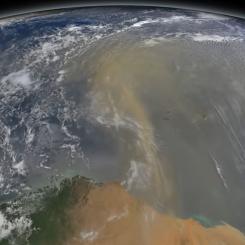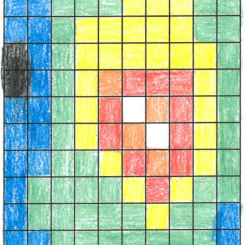Lesson Plans
How the 2020 Creek Fire Impacted Air Quality
Overview
Students observe maps that show smoke and AOD levels during the 2020 Creek Fire. Then, students construct a claim identifying a relationship between fire and air quality data. To support their claim, students select evidence from the maps and use reasoning to draw connections to their claim.
Materials Required
For Students to View:
- Video: Engine 331 - The Story of One of the First Engines to Respond (https://www.youtube.com/watch?v=e1xyiqr_KV0&t=193s)
- Article: Aerosol Optical Depth (https://earthobservatory.nasa.gov/global-maps/MODAL2_M_AER_OD)
1 per Group of Students (printed or shared on Google Classroom):
Procedure
Engage
(10 min) Capture students interest in the Creek Fire:
- As students watch, Engine 331 - The Story of One of the First Engines to Respond , they will record:
- One question that they would ask Captain Juan Ybarra if given the opportunity.
- What they notice about the sky as Creek Fire grows
- Turn & Talk: Students will share their question and observations with a partner.
- Share Out: Teacher will call on a few students to share out their question and observations.
Explain
(2 min) Framing the Lesson:
- Teacher explains that without any instruments we can observe the visibility or haziness of the sky to assess the air quality. However, scientists can also use satellites to make images of Earth’s atmosphere from above and take measurements of air quality. In these lessons, we will look at images surrounding the Creek Fire that show us Aerosol Optical Depth which is one way that we can measure air quality.
(13 min) Acquire Background Knowledge:
- Students individually read the article Aerosol Optical Depth.
- In pairs, students create a Frayer Model for the term, Aerosol Optical Depth.
- Teacher highlights key information shown on students’ Frayer Models and addresses any misconceptions that they observed in students’ Frayer Models.
- See the teacher answer key for a sample of possible answers.
Explore
- Materials:
- AOD Images from 2020 Creek Fire
- (10 min) Observe Satellite Images
- Students observe AOD Images from 2020 Creek Fire and record observations, questions, and connections to the engage and explain activities as well as to prior learning.
- Technology options: teacher may project images for all students to view or 2-3 students may look on a shared laptop.
Elaborate
(25 min) Claim, Evidence, Reasoning
- Students will create a Claim, Evidence, Reasoning statement that answers their own question related to the AOD Images from 2020 Creek Fire.
- While there are not precise answers, please refer to the answer key for the Creek Fire CER, which serves as a model of a scientific explanation based on AOD Images from 2020 Creek Fire.
- Construct your CER Question:
- Choose one type of fire data shown on AOD Images from 2020 Creek Fire.
- Containment of Creek Fire
- Acreage burned
- Smoke Observations shown on True Color Maps
- Choose one type of air quality data shown on AOD Images from 2020 Creek Fire.
- Aerosol Optical Depth (AOD)
- Air Quality Index (AQI)
- Use the sentence frame below to write your CER Question.
-
CER Sentence Frame: What is the relationship between ___________________ and ___________________ ?
(fire data) (air quality data)
OR create your own open-ended question! Just make sure to get it approved by a teacher.
-
- Choose one type of fire data shown on AOD Images from 2020 Creek Fire.
- Select Evidence that will help you answer your question.
- Collect evidence from AOD Images from 2020 Creek Fire that will help you answer your question. Take notes on data from specific dates.
- Construct an Outline
- Assess the evidence that you’ve collected and construct a 1-2 sentence claim that directly answers your CER question.
- Select 2-3 pieces of evidence that best support your claim.
- As reasoning, explain why these pieces of evidence support your claim.
- Construct a Scientific Explanation
- Construct a paragraph that begins with your claim and is supported by your evidence and reasoning.
Evaluate
(5 min) Assessment
- Students self-assess their work using the rubric below. Based on their self-assessment, students revise their CER.
- After students have revised their CER, teachers use the rubric below to grade students’ work.
Answer Key:
Teachers who are interested in receiving the answer key, please complete the Teacher Key Request and Verification Form. We verify that requestors are teachers prior to sending access to the answer keys as we’ve had many students try to pass as teachers to gain access.
Sources:
- (n.d.). YouTube. Retrieved July 22, 2022, from https://www.youtube.com/watch?v=e1xyiqr_KV0&t=193s
- Global Map Aerosol Optical Depth Image 1. (n.d.). NASA Earth Observatory. Retrieved July 22, 2022, from https://earthobservatory.nasa.gov/global-maps/MODAL2_M_AER_OD
Disciplinary Core Ideas:
- ESS3C: Human Impacts on Earth Systems
Crosscutting Concepts:
- Cause and Effect
- Scale, Proportion, and Quantity
- Systems and System Models
Science and Engineering Practices:
- Asking Questions and Defining Problems
- Analyzing and Interpreting Data
- Obtaining, Evaluating and Communicating Information
Illustrate a relationship to show how the 2020 Creek Fire impacted air quality in central California.
How did the 2020 Creek Fire impact air quality in central California?
- The sources of poor air quality are purely factories and cars, burning fossil fuels.
- Air pollution in China always exceeds that of the US.
- Air pollution is present only if you can see it.
- The air quality is always better indoors vs. outdoors.
- The air quality of natural areas always exceeds that of cities.
Source:
Barrette, A. (2018, September 29). 6 Common Myths About Air Pollution and What You Can Do About Them. Molekule Blog. Retrieved July 22, 2022, from https://molekule.science/common-myths-about-air-pollution/
Land use, agriculture, national parks and forestry in geography, social studies, environmental science, and biology classes
NASA studies this phenomenon to better understand how forest fires impact air quality. As climate change increases the likelihood and intensity of forest fires, this data can be used to help governments to better adapt to a warming world. The data can also be used to protect human respiratory health when air quality worsens due to forest fires.
As forest fires become more common in the western United States, STEM careers related to fire management and climate adaptation are especially relevant.
There are many related careers. The list below is a small sample of those careers.
- Internet Required
- One-to-One (tablet, laptop, or CPU)
- One-to-a-Group
- Teacher computer/projector only
- Color Printer






















